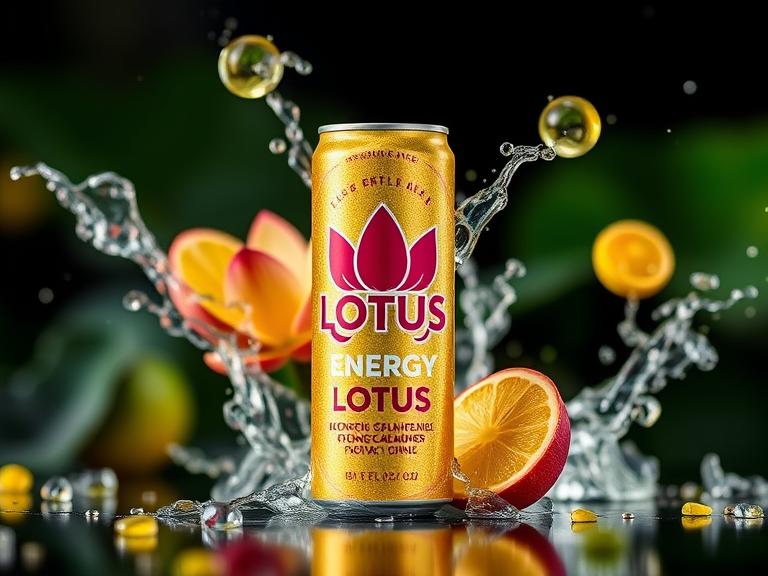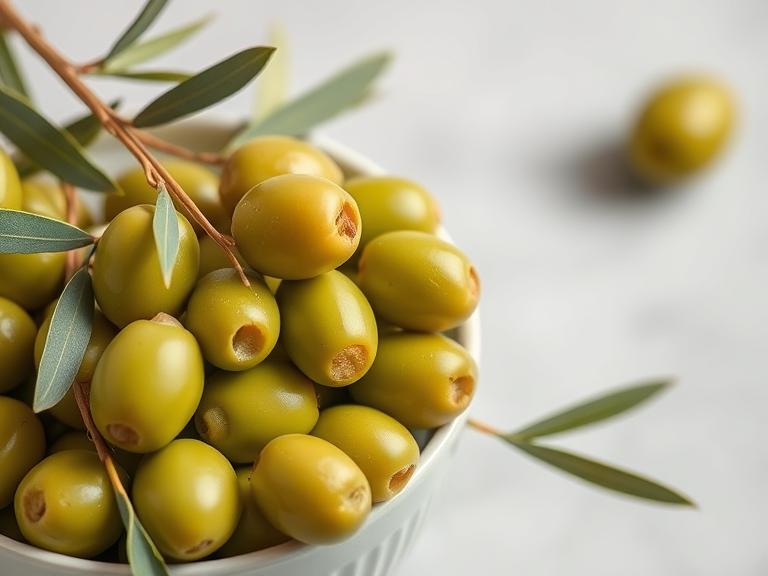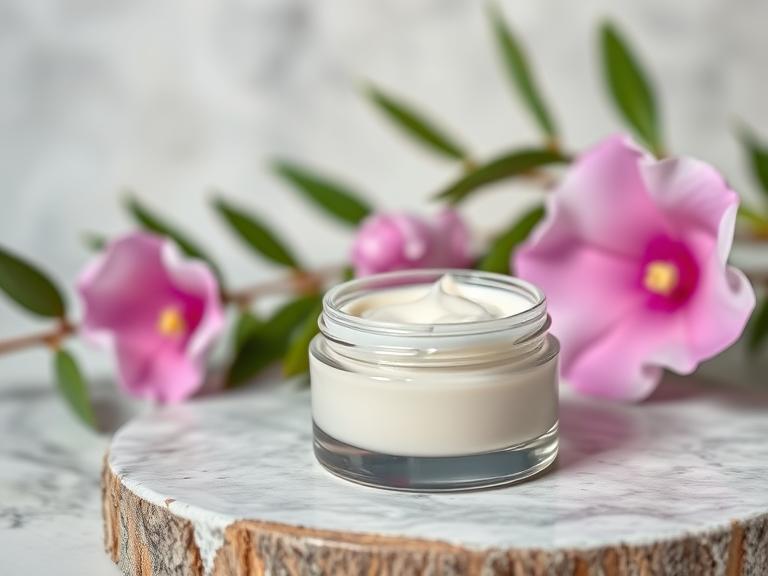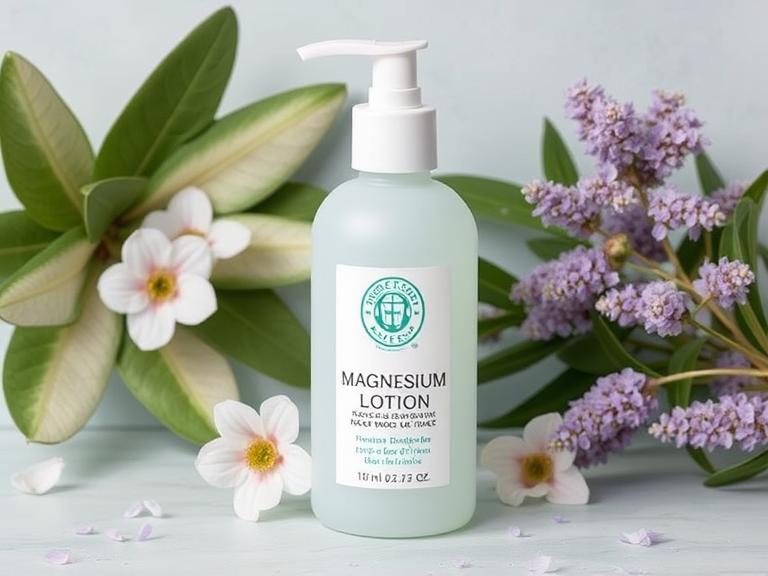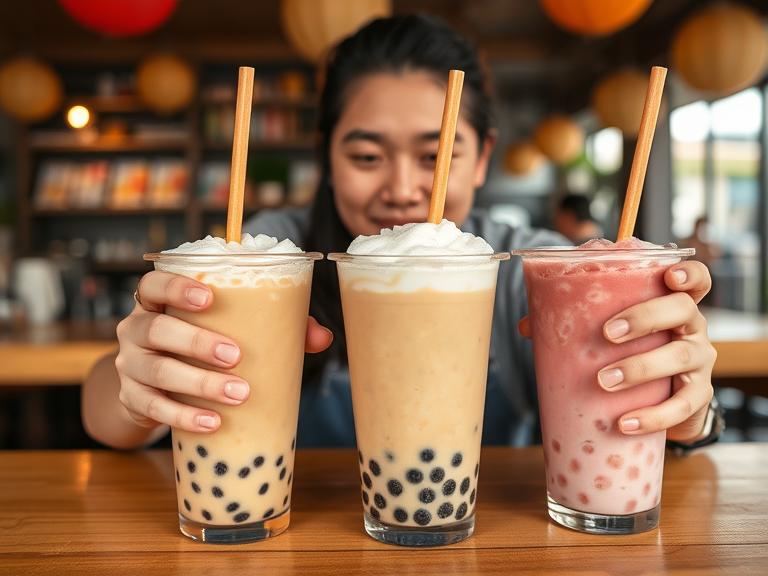
Popping Boba
Popping Boba
Table of Contents
The world of bubble tea has grown a lot in popularity. Popping boba is a big part of this growth. These fun, bursting bubbles make drinking tea more exciting.
Bubble tea lovers enjoy the unique feel and taste of boba flavors. There are many flavors to choose from, from classic fruits to new and creative ones. The variety of boba is huge and fun.
Key Takeaways
- Discover the refreshing world of popping boba and its role in bubble tea.
- Explore the diverse range of boba flavors available.
- Learn how boba enhances the bubble tea experience.
- Understand the significance of popping boba in the bubble tea culture.
- Find out why boba has become a favorite among bubble tea enthusiasts.
What Makes Popping Boba Unique in the World of Bubble Tea
Popping boba adds a new twist to bubble tea, giving fans a special treat. It has won many hearts, but what makes it different from other bubble tea toppings?
The Science Behind the Pop: Liquid-Filled Spheres
The magic of boba is in its spherification process. It makes liquid-filled spheres that pop when you eat them. Sodium alginate and calcium chloride mix to create a thin skin around a liquid inside. This leads to a fun popping sensation that fills your mouth with tasty juice.
Popping Boba vs. Traditional Tapioca Pearls: Texture and Experience
Popping boba is unlike traditional tapioca pearls, which are chewy. It bursts with flavor. The difference in texture changes how you enjoy your bubble tea. Here’s a quick look at how they compare:
| Characteristics | Popping Boba | Traditional Tapioca Pearls |
| Texture | Liquid-filled, bursting | Chewy, dense |
| Flavor Experience | Releases flavorful juice | Typically neutral, absorbs tea flavor |
| Preparation Method | Spherification process | Cooking tapioca starch |
This comparison shows how popping boba stands out. Its unique texture and flavor make it a favorite among bubble tea lovers.
The Evolution of Popping Boba: From Novelty to Mainstream
Popping boba’s journey from a rare find to a favorite drink is quite interesting. It has become a key part of the bubble tea world. It offers a special texture and taste that people all over love.
Origin Story and Development Timeline
In the early 2000s, boba started in Taiwan. It was first seen as a fun topping for bubble tea. The idea was to make a liquid-filled ball that would burst in your mouth, releasing its flavor.
This was done through a method called spherification. It uses sodium alginate and calcium chloride. Soon, it became popular in Asia and then around the world.
Rising Popularity in American Bubble Tea Culture
In the US, popping boba became more popular as bubble tea grew. People loved its unique feel and taste. It became a must-have in many bubble tea places.
Social media also helped it become more popular. Drinks with boba were shared online, making it even more sought after.
| Year | Event | Impact on Popping Boba |
| Early 2000s | Introduction of popping boba in Taiwan | Initial popularity in Asia |
| 2010s | Global expansion of bubble tea culture | Increased availability worldwide |
| 2020s | Rise of social media sharing | Mainstream popularity in the US |
Top 10 Popping Boba Flavors Trending in 2025
In 2025, popping boba is getting more exciting. We see a mix of old favorites, new discoveries, and creative flavors. Bubble tea fans are eager to try new tastes, making the variety in boba flavors more exciting than ever.
Classic Fruit Flavors: Mango, Strawberry, and Lychee
Classic fruit flavors are always in style for boba. Mango, strawberry, and lychee are top picks. They offer a sweet and refreshing taste that many enjoy.
- Mango: Mango popping boba is sweet and tropical, perfect for a fruity twist in bubble tea.
- Strawberry: Strawberry popping boba is sweet and slightly tart, loved by kids and adults alike.
- Lychee: Lychee popping boba has a unique floral sweetness, great with green tea or fruit drinks.
Exotic Options: Passion Fruit, Dragon Fruit, and Yuzu
For those who want to try something new, exotic flavors like passion fruit, dragon fruit, and yuzu are becoming popular. These unique tastes add an adventurous twist to bubble tea, appealing to those looking for something new.
- Passion Fruit: Passion fruit popping boba is tangy and sweet, bringing a tropical vibe to bubble tea.
- Dragon Fruit: Dragon fruit boba is not only tasty but also adds a vibrant touch to drinks.
- Yuzu: Yuzu popping boba offers a citrusy and refreshing flavor, perfect for those who like a tangy drink.
Innovative Creations: Coffee, Taro, and Brown Sugar
New flavors like coffee, taro, and brown sugar are changing the popping boba scene. These flavors appeal to a wide range of tastes, from coffee lovers to those who enjoy sweet or nutty flavors.
- Coffee: Coffee popping boba is a favorite among coffee fans, adding a rich flavor to milk tea or coffee drinks.
- Taro: Taro popping boba has a nutty and sweet taste, great in creamy milk teas.
- Brown Sugar: Brown sugar popping boba has a deep, caramel-like sweetness, perfect with various tea bases.
How Popping Boba is Made: The Spherification Process
The making of popping boba is a cool process called spherification. It turns liquid into small, tasty balls. This is what makes popping boba special and fun in bubble tea.
Ingredients and Chemical Reactions Explained
The spherification process uses a chemical reaction between sodium alginate and calcium chloride. Sodium alginate comes from seaweed and is mixed with flavor and color. This creates the liquid boba mixture.
When this mixture meets a calcium chloride bath, a reaction happens. It forms a thin membrane around the liquid, making the popping boba.
The right mix of sodium alginate and calcium chloride is key. Too little alginate, and the spheres won’t form right. Too much, and they get too hard. The calcium chloride’s strength also matters for the membrane’s thickness. Makers must get this just right for the perfect popping boba.
Artisanal vs. Commercial Production Methods
Artisanal and commercial popping boba makers have different ways of doing things. Artisanal makers do it by hand, making each batch special. This lets them control the quality and flavor better.
Commercial makers, though, make it on a big scale. They use machines to make lots of popping boba quickly. But, this can make the flavor and texture less unique than artisanal methods.
Health Considerations: Nutritional Profile of Popping Boba
Popping boba makes bubble tea fun and tasty. But, it’s important to think about its health effects. Knowing what’s in popping boba helps us make better choices.
Calorie and Sugar Content Comparison
Popping boba has fewer calories than tapioca pearls. But, its sugar level changes with flavor. Fruit flavors like mango and strawberry have more sugar than others.
- Fruit flavors: Higher sugar content
- Neutral flavors: Lower sugar content
A serving of popping boba, about 10-15 pieces, has 60 to 120 calories. Most of these calories come from sugar.
Dietary Restrictions and Allergen Information
Most popping boba is gluten-free because it’s made from sodium alginate and calcium chloride. But, some flavors might have soy or tree nuts, which are allergens.
Key considerations:
- Gluten-free status
- Potential allergens: soy, tree nuts
Knowing this helps us pick popping boba that fits our diet. We can enjoy it while staying healthy.
Perfect Pairings: Best Tea Bases for Different Popping Boba Flavors
Exploring the perfect tea base for popping boba flavors is a fun journey. The right match can make your bubble tea even more delightful.
Choosing the right tea base is key when pairing it with popping boba. Some teas enhance the boba’s flavors, while others create a unique taste.
Fruit Flavors with Green and White Teas
Fruit-flavored popping boba, like mango or strawberry, goes well with green or white tea. These teas’ light, refreshing taste complements the fruit without overpowering it.
Rich Flavors with Black and Oolong Teas
For bold flavors like coffee or taro, black or oolong tea is a better choice. Black tea’s strong taste and oolong’s complex flavor can match the boba’s boldness.
Creating Balanced Flavor Profiles
To balance flavors, think about the intensity and characteristics of both the tea and boba. Trying different combinations can help you find your favorite pairing.
| Popping Boba Flavor | Recommended Tea Base | Flavor Profile |
| Mango | Green Tea | Fruity and Refreshing |
| Coffee | Black Tea | Rich and Bold |
| Lychee | White Tea | Delicate and Fruity |
Beyond Bubble Tea: Creative Uses for Popping Boba
Popping boba has grown from a simple bubble tea topping to a key ingredient in desserts and drinks. Its unique texture and burst of flavor make it exciting in many dishes.
Dessert Applications: Yogurt, Ice Cream, and Shaved Ice
Popping boba brings fun to traditional desserts. It adds a refreshing burst to yogurt parfaits. Ice cream shops now offer unique sundaes and milkshakes with popping boba.
Shaved ice desserts get a delightful twist with popping boba. It offers a fun textural contrast.
Beverages: Cocktails, Mocktails, and Specialty Drinks
Mixologists are using popping boba in creative cocktails and mocktails. It adds a fun surprise to drinks. Specialty coffee shops are also experimenting with popping boba in cold brews and coffee desserts.
Popping boba’s versatility makes it great for many drinks. It’s perfect in fruity spritzers and creamy lattes.
The culinary world is always innovating. We’ll see popping boba in even more desserts and drinks. Its flavor and fun make it a valuable ingredient for chefs and mixologists.
DIY Popping Boba: Make Your Own at Home
Making popping boba at home lets you try new flavors and textures. You can use simple ingredients and basic tools to make it. Start making your own popping boba today.
Essential Equipment and Ingredients List
To start, you need some key tools and ingredients. Here’s what you’ll need:
- Sodium alginate
- Calcium chloride
- Water
- Flavorings or fruit purees
- A syringe or squeeze bottle
- A bowl or container for the calcium chloride bath
Using high-quality ingredients is key for great-tasting and textured popping boba.
Step-by-Step Recipe Guide with Tips
Here’s a simple recipe to make popping boba at home:
- Mix 1-2% sodium alginate with water to create the boba mixture.
- Add flavorings or fruit purees to the mixture.
- Using a syringe or squeeze bottle, drop the mixture into a bath of water containing calcium chloride (0.5-1%).
- The droplets will form into spheres that burst in your mouth.
Tip: Try different flavor mixes and adjust the sodium alginate to water ratio for the right texture.
Troubleshooting Common Issues and Storage Solutions
If you run into problems with your popping boba, here are some tips:
| Issue | Solution |
| Boba too fragile | Increase sodium alginate concentration |
| Boba too firm | Decrease sodium alginate concentration |
| Boba not bursting | Check calcium chloride concentration |
Keep your popping boba fresh by storing them in an airtight container in the fridge.
Where to Find the Best Popping Boba in the United States
Popping boba is a big hit in American bubble tea culture. We’re here to help you find the best places to try it. The U.S. has a wide range of bubble tea shops and chains, all serving top-notch popping boba.
Top National Bubble Tea Chains with Premium Offerings
Many national bubble tea chains are known for their premium popping boba. ShareTea and Gong Cha are favorites for their wide flavor range and quality ingredients. You can find these chains all over the country, making it easy to enjoy a great popping boba drink.
Chatime is another standout, with popping boba flavors that match their signature teas perfectly. These big chains offer consistency and keep things exciting with new flavors and mixes.
Regional Specialties and Local Hidden Gems
But don’t overlook local, independent shops for the best popping boba. Cities like Los Angeles, New York, and San Francisco have unique bubble tea spots. For example, some California shops use fresh, local fruit for their popping boba flavors.
Checking out local bubble tea shops can reveal hidden gems. These places often try out new and unique flavors, giving customers a special experience.
Sustainability in the Popping Boba Industry: Eco-Friendly Trends for 2025
More people are caring about the planet, and the popping boba world is taking notice. In 2025, we’re seeing big changes towards green practices in making and packaging popping boba.
Biodegradable Packaging Innovations
Biodegradable packaging is a big deal now. Companies are working on materials that can break down easily or come from plants. For example, some use PLA (Polylactic Acid), made from corn or sugarcane, to wrap their products. This move cuts down on plastic waste and helps the environment.
Sustainable Ingredient Sourcing Practices
Choosing the right ingredients is also important. Makers are focusing on sustainable ingredients like natural flavors and colors from fruits and veggies. This makes production greener and meets the growing need for natural products.
By going green, the popping boba industry is making a positive impact. It’s also winning over customers who care about the planet.
Conclusion:
Popping boba has become a favorite in the bubble tea world. It’s loved for its fun texture and tasty flavors. The science behind it and the many flavors available keep it popular.
Popping boba is loved for its flexibility and the fun ways to enjoy it. You can find everything from classic fruit flavors to new and exciting ones. As bubble tea grows, popping boba leads the way, pushing the industry forward.
For fans of bubble tea, popping boba is more than a topping. It’s a special experience. The thrill of biting into a boba and feeling the burst of flavor is unique. As more people want popping boba, businesses keep coming up with new flavors, making it even more popular.
FAQ
What is popping boba made of?
Popping boba is made from water, sugar, and sodium alginate. It’s then dropped into a calcium chloride bath. This creates small, liquid-filled spheres.
Are popping boba and tapioca pearls the same thing?
No, they are not the same. Tapioca pearls are chewy and made from tapioca starch. Popping boba has a liquid center that “pops” in your mouth.
Can I make popping boba at home?
Yes, you can make popping boba at home. Use sodium alginate and calcium chloride. Many recipes online can guide you through it.
What are some popular flavors of popping boba?
Popular flavors include mango, strawberry, and lychee. You can also find passion fruit, yuzu, coffee, taro, and brown sugar.
Are popping boba suitable for people with dietary restrictions?
Popping boba might be okay for some dietary needs. But, always check the ingredients. They can be high in sugar and calories.
How do I store popping boba?
Store popping boba in an airtight container in the fridge. This keeps them fresh. It’s best to use them within a few days.
Also Read
Plastic Surgeons on Ozempic Face: Expert Insights & Care In 2025
Daily Care for Dogs: Essential Tips for Happy, Healthy Pets 2025
Organic Castor Oil for Hair Growth & Skin Care Benefits in USA 2025
Under Eye Filler Treatment – Reduce Dark Circles & Wrinkles in 2025

